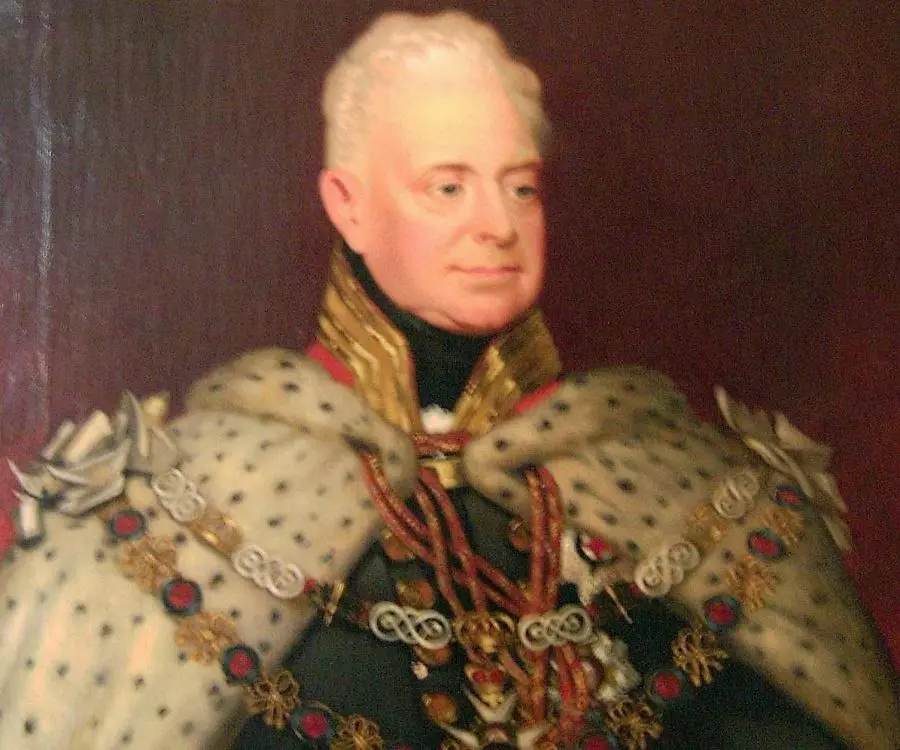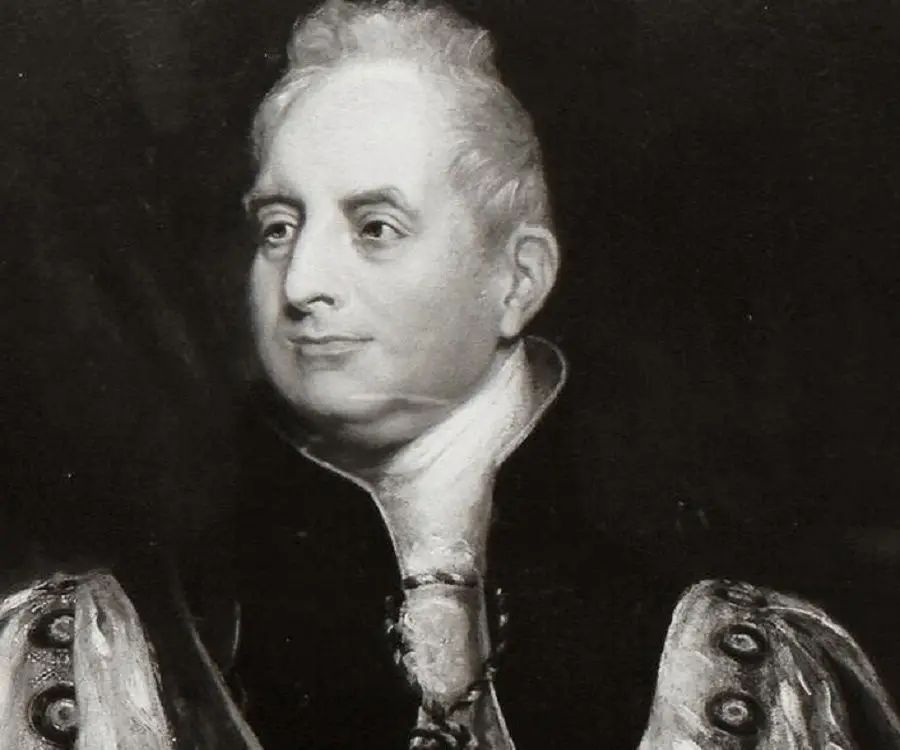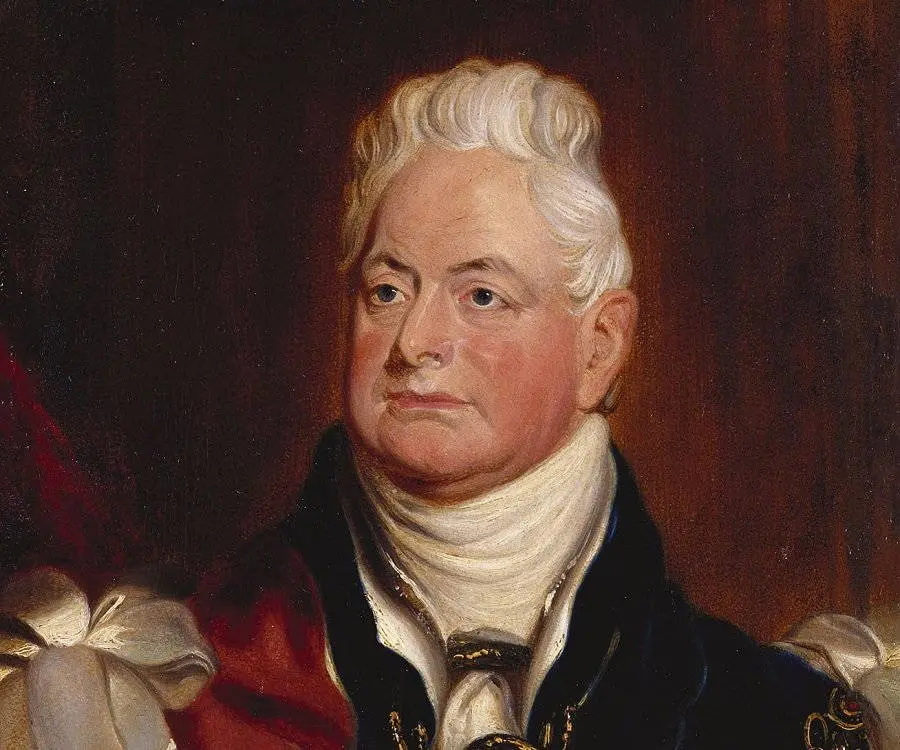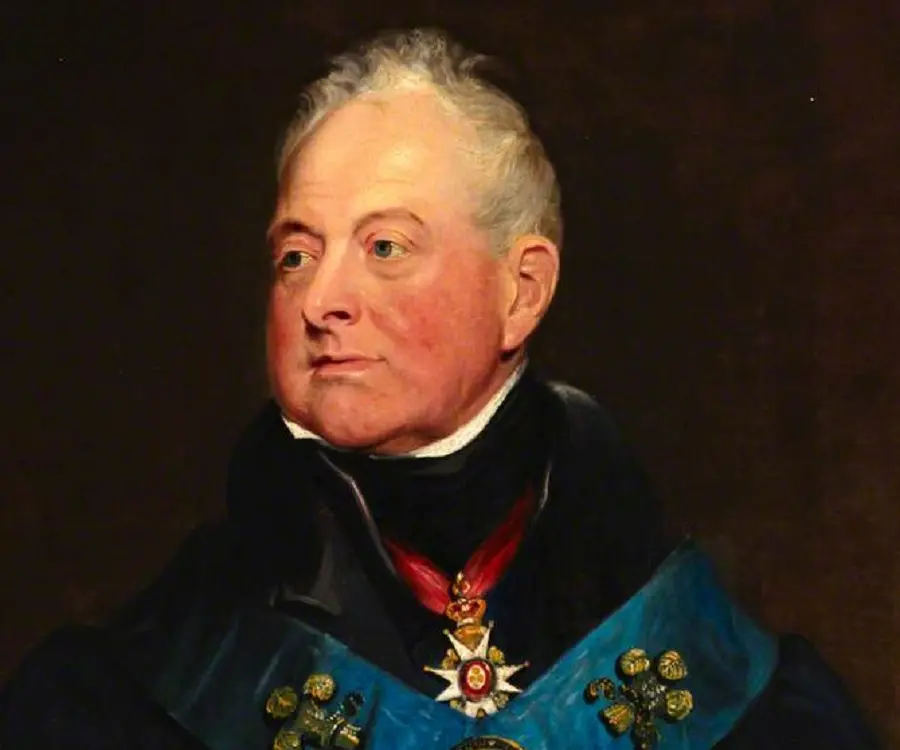
William IV of the United Kingdom - Kings, Family and Life
William IV of the United Kingdom's Personal Details
William IV was the King of United Kingdom of Great Britain and Ireland, under whose reign the revolutionary ‘Reform Act of 1832’ was passed.
| Information | Detail |
|---|---|
| Birthday | August 21, 1765 |
| Died on | June 20, 1837 |
| Nationality | British |
| Famous | Historical Personalities, Emperors & Kings, Emperors, King of Hanover, King of the United Kingdom of Great Britain, Kings |
| Spouses | Adelaide of Saxe-Meiningen, Dorothea Jordan |
| Siblings | Ernest Augustus I of Hanover, George IV of the United Kingdom |
| Known as | The Prince William, 1st Duke of Clarence and St Andrews |
| Childrens | 1st Earl of Munster, Amelia Cary, Countess of Erroll, Elizabeth Hay, George FitzClarence, Henry FitzClarence, Lady Mary Fox, Lord Adolphus FitzClarence, Lord Frederick FitzClarence, Princess Charlotte of Clarence, Princess Elizabeth of Clarence, Sophia Sidney, Viscountess Falkland |
| Birth Place | Buckingham Palace |
| Gender | Male |
| Father | George III of the United Kingdom |
| Mother | Charlotte of Mecklenburg-Strelitz |
| Sun Sign | Leo |
| Born in | Buckingham Palace |
| Famous as | King of the United Kingdom of Great Britain and Ireland and King of Hanover |
| Died at Age | 71 |
William IV of the United Kingdom's photo
Who is William IV of the United Kingdom?
William IV was the King of United Kingdom of Great Britain and Ireland from 1830 to 1837, under whose reign the revolutionary ‘Reform Act of 1832’ was passed. Born in England, he was the third son of George III, and as such was not expected to succeed to the throne. Brought up since childhood for a naval career, he joined the Royal Navy in his teenage years and enjoyed his time at sea, later becoming the captain of a frigate and eventually the admiral of the fleet. Afterwards, he was created the Duke of Clarence, took retirement from his active service, and went to live with his mistress with whom he had ten illegitimate children. He spent the next two decades calmly with them but after the death of prince regent’s only daughter, a race began among the royal dukes to marry and produce legitimate heir for the throne. Therefore, he married and upon the death of George IV, was crowned the King of England as William IV. Initially very popular among all classes, William’s reign was mostly dominated by the Reform crisis. The Reform Act of 1832, passed after much parliamentary debates, abolished some of the worst misuses of the electoral system and extended the franchise to the middle classes. After ruling for seven years, William died without any surviving legitimate children and his niece, Victoria succeeded him to the throne.
Childhood & Early Life
William was born on August 21, 1765, in Buckingham House, London, to George III, the King of United Kingdom of Great Britain and Ireland, and his wife, Queen Charlotte of Mecklenberg-Strelitz.
He was the third son of the royal couple and was baptised in the Great Council Chamber of St James's Palace in September 1765. With several siblings which consisted of two elder brothers, he was not expected to inherit the Crown.
After receiving most of his early education from private tutors, at the age of 13, he joined the crew of the Prince George as a midshipman.
In 1785, he was appointed a Lieutenant and the following year, became the Captain of HMS Pegasus. In 1788, he was given command of the frigate HMS Andromeda and was later promoted to Rear-Admiral in command of HMS Valiant.
Accession & Reign
In 1789, William became the Duke of Clarence and St. Andrews and Earl of Munster. Being the third son of the King, he was not expected to figure in the succession and therefore had no legitimacy issues.
In 1790, he retired from active service and subsequently lived with an Irish actress, Dorothea Bland and had ten illegitimate children. All the children were given the surname ‘FitzClarence’. The couple lived together for 20 years, from 1791 to 1811.
With the death of Princess Charlotte in 1817, daughter of Prince Regent’s only child and second-in-line to the throne, a succession crisis arose in the royal family. Subsequently, the parliament offered William an incentive of paying his large debts if he agreed to marry and produce a legitimate heir to the throne.
After several rebuffs, William married Princess Adelaide of Saxe-Coburg and Meiningen, daughter of George I, Duke of Saxe-Meiningen. In 1830, upon the death of his elder brother, George IV, William ascended the throne, becoming the King of United Kingdom of Great Britain and Ireland as well as the King of Hanover.
William IV was a good natured king and was received with enthusiasm by all ranks of society. When he ascended the throne, parliamentary reform crisis was in motion. In 1831, upon acquiring majority in the House of Commons, the Whig party leader, Lord Grey, pushed a Reform Bill in the Commons but was defeated in the House of Lords.
In 1832, when William eventually agreed to create enough new Whig peers to get the Bill through the House of Lords, the Lords backed down and the Bill was passed in both the chambers. William’s reign also saw several other reforms; the Poor Law was enacted, child labor was restricted, and slavery was abolished in nearly all the British Empire.
After William’s two short-lived daughters, William and his wife were unable to produce a child of their own. Subsequently, William's niece, the young Princess Victoria, daughter of William's deceased younger brother, Edward, Duke of Kent, came to be accepted as heiress presumptive to the crown.
Upon William’s death, the joint rule of England and Hanover was separated. Princess Victoria ascended the throne of England and the rule of Hanover was passed on to Ernest, the Duke of Cumberland, one of William's younger brothers.
Major Works
The most significant reform passed under William’s reign was that of the modernizing of British electoral system by the revolutionary ‘Reform Act of 1832’. The 1832 Reform Act extended the voting franchise to middle class land owners and became the basis for further Acts which eventually emancipated all adult subjects.
Personal Life & Legacy
From 1791 onwards, William IV lived with his mistress, Dorothea Bland, an Irish stage actress better known by her stage name, Mrs. Jordan. The couple remained together for 20 years and had ten illegitimate children; five sons and five daughters, and all were given the surname ‘FitzClarence’.
In 1818, William married Princess Adelaide of Saxe-Coburg and Meinengein, the daughter of George I, Duke of Saxe-Meiningen. The couple had two daughters, both of which died in early childhood and Adelaide suffered several miscarriages.
William IV died on June 20, 1837, in Windsor Castle, Berkshire, leaving behind no legitimate children. He was buried on July 8, 1837, at St. George's Chapel, Windsor.
// Famous Kings
Sundiata Keita
Sundiata Keita was the founder of the Mali Empire in West Africa. This biography profiles his childhood, early life, struggles, founding of empire, rule, administration, achievements and also gives some fun facts.
Ashoka
Ashoka was the third emperor of the Mauryan Dynasty and ruled almost the entire Indian subcontinent. This biography profiles his childhood, life, reign, achievements and timeline
Murad IV
Murad IV was one of the mighty Sultans in the history of the Ottoman Empire. This biography profiles his childhood, family, accession, rule, administration and timeline.
William IV of the United Kingdom biography timelines
- // 21st Aug 1765William was born on August 21, 1765, in Buckingham House, London, to George III, the King of United Kingdom of Great Britain and Ireland, and his wife, Queen Charlotte of Mecklenberg-Strelitz.
- // Sep 1765He was the third son of the royal couple and was baptised in the Great Council Chamber of St James's Palace in September 1765. With several siblings which consisted of two elder brothers, he was not expected to inherit the Crown.
- // 1785 To 1788In 1785, he was appointed a Lieutenant and the following year, became the Captain of HMS Pegasus. In 1788, he was given command of the frigate HMS Andromeda and was later promoted to Rear-Admiral in command of HMS Valiant.
- // 1789In 1789, William became the Duke of Clarence and St. Andrews and Earl of Munster. Being the third son of the King, he was not expected to figure in the succession and therefore had no legitimacy issues.
- // 1790In 1790, he retired from active service and subsequently lived with an Irish actress, Dorothea Bland and had ten illegitimate children. All the children were given the surname ‘FitzClarence’. The couple lived together for 20 years, from 1791 to 1811.
- // 1791From 1791 onwards, William IV lived with his mistress, Dorothea Bland, an Irish stage actress better known by her stage name, Mrs. Jordan. The couple remained together for 20 years and had ten illegitimate children; five sons and five daughters, and all were given the surname ‘FitzClarence’.
- // 1817With the death of Princess Charlotte in 1817, daughter of Prince Regent’s only child and second-in-line to the throne, a succession crisis arose in the royal family. Subsequently, the parliament offered William an incentive of paying his large debts if he agreed to marry and produce a legitimate heir to the throne.
- // 1818In 1818, William married Princess Adelaide of Saxe-Coburg and Meinengein, the daughter of George I, Duke of Saxe-Meiningen. The couple had two daughters, both of which died in early childhood and Adelaide suffered several miscarriages.
- // 1830After several rebuffs, William married Princess Adelaide of Saxe-Coburg and Meiningen, daughter of George I, Duke of Saxe-Meiningen. In 1830, upon the death of his elder brother, George IV, William ascended the throne, becoming the King of United Kingdom of Great Britain and Ireland as well as the King of Hanover.
- // 1831William IV was a good natured king and was received with enthusiasm by all ranks of society. When he ascended the throne, parliamentary reform crisis was in motion. In 1831, upon acquiring majority in the House of Commons, the Whig party leader, Lord Grey, pushed a Reform Bill in the Commons but was defeated in the House of Lords.
- // 1832In 1832, when William eventually agreed to create enough new Whig peers to get the Bill through the House of Lords, the Lords backed down and the Bill was passed in both the chambers. William’s reign also saw several other reforms; the Poor Law was enacted, child labor was restricted, and slavery was abolished in nearly all the British Empire.
- // 1832The most significant reform passed under William’s reign was that of the modernizing of British electoral system by the revolutionary ‘Reform Act of 1832’. The 1832 Reform Act extended the voting franchise to middle class land owners and became the basis for further Acts which eventually emancipated all adult subjects.
- // 8th Jul 1837William IV died on June 20, 1837, in Windsor Castle, Berkshire, leaving behind no legitimate children. He was buried on July 8, 1837, at St. George's Chapel, Windsor.
// Famous Emperors
Sundiata Keita
Sundiata Keita was the founder of the Mali Empire in West Africa. This biography profiles his childhood, early life, struggles, founding of empire, rule, administration, achievements and also gives some fun facts.
Ashoka
Ashoka was the third emperor of the Mauryan Dynasty and ruled almost the entire Indian subcontinent. This biography profiles his childhood, life, reign, achievements and timeline
Murad IV
Murad IV was one of the mighty Sultans in the history of the Ottoman Empire. This biography profiles his childhood, family, accession, rule, administration and timeline.
Xerxes I
Xerxes I (Xerxes the Great) was the fourth and the most famous king of the Archaemenid dynasty of Persia. This biography profiles his childhood, family, personal life, life history, achievements, campaigns, administration, death and other facts.
Sargon of Akkad
Sargon of Akkad, also called ‘Sargon the Great’, ‘Sarru-Kan’ and ‘Shar-Gani-Sharri’, was the founder and first king of the Akkadian Empire. This biography profiles his childhood, life, rule, administration, timeline, and gives some fun facts.
Abdullah of Saudi Arabia
Abdullah bin Abdulaziz Al Saud was the King of Saudi Arabia from 2005 to 2015 and the third wealthiest head of state in the world. Find more facts about his life, childhood and timeline.
William IV of the United Kingdom's FAQ
What is William IV of the United Kingdom birthday?
William IV of the United Kingdom was born at 1765-08-21
When was William IV of the United Kingdom died?
William IV of the United Kingdom was died at 1837-06-20
Where was William IV of the United Kingdom died?
William IV of the United Kingdom was died in Windsor Castle
Which age was William IV of the United Kingdom died?
William IV of the United Kingdom was died at age 71
Where is William IV of the United Kingdom's birth place?
William IV of the United Kingdom was born in Buckingham Palace
What is William IV of the United Kingdom nationalities?
William IV of the United Kingdom's nationalities is British
Who is William IV of the United Kingdom spouses?
William IV of the United Kingdom's spouses is Adelaide of Saxe-Meiningen, Dorothea Jordan
Who is William IV of the United Kingdom siblings?
William IV of the United Kingdom's siblings is Ernest Augustus I of Hanover, George IV of the United Kingdom
Who is William IV of the United Kingdom childrens?
William IV of the United Kingdom's childrens is 1st Earl of Munster, Amelia Cary, Countess of Erroll, Elizabeth Hay, George FitzClarence, Henry FitzClarence, Lady Mary Fox, Lord Adolphus FitzClarence, Lord Frederick FitzClarence, Princess Charlotte of Clarence, Princess Elizabeth of Clarence, Sophia Sidney, Viscountess Falkland
Who is William IV of the United Kingdom's father?
William IV of the United Kingdom's father is George III of the United Kingdom
Who is William IV of the United Kingdom's mother?
William IV of the United Kingdom's mother is Charlotte of Mecklenburg-Strelitz
What is William IV of the United Kingdom's sun sign?
William IV of the United Kingdom is Leo
How famous is William IV of the United Kingdom?
William IV of the United Kingdom is famouse as King of the United Kingdom of Great Britain and Ireland and King of Hanover










